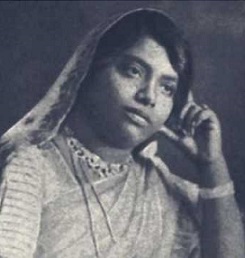(১৯০০-১৯৮৪)
বিশিষ্ট কণ্ঠশিল্পী।
১৯০০ খ্রিষ্টাব্দের ১৯ আগষ্ট জন্মগ্রহণ করেন।
কোনো কোনো মতে- তিনি জন্মগ্রহণ করেছিলেন ১৮৯৬ খ্রিষ্টাব্দের
জুলাই মাসে। এঁর পৈত্রিক নিবাস বর্ধমানের ইন্দ্রাস।
জন্মস্থান নিয়ে মতভেদ আছে। কোনো কোনো মতে তিনি বর্ধমানের ইন্দ্রাসে জন্মগ্রহণ
করেছিলেন। আবার কোনো কোনো মতে- উত্তর কলকাতার কাশীপুরে জন্মগ্রহণ করেন।
পিতার নাম বি জলী ভূষণ বন্দ্যোপাধ্যায়
(সেনা অফিসার) । তাঁর অন্যনাম ছিল সুধীরকুমার বন্দ্যোপাধ্যায়। মায়ের
নাম হীরামতি দেবী। তাঁর পিতৃদত্ত নাম ছিল প্রভাবতী দেবী। ডাক
নাম ছিল নেড়া।
তাঁর শৈশব কেটেছিল কলকাতার শ্যামপুকুর অঞ্চলে।
আর প্রাথমিক শিক্ষা শুরু হয়েছিল দর্জিপাড়ায় জয়রাম মিত্র স্ট্রিটের মিশনারি স্কুলে। এরপর
তিনি হেঁদোর কাছে নরম্যাল স্কুলে ভর্তি হ ন ।
এই স্কুল থেকে ছাত্রবৃত্তির পরীক্ষায় তিনি
বৃত্তি লাভ করেন ।
শৈশব থেকে তাঁর গানে দারুন উৎসাহ ছিল। ছোটবেলায় বেলায়
তিনি একবার যে কোনো গান শুনেই কণ্ঠে তুলে নিতে পারতেন। গানের প্রতি আগ্রহ দেখে মা
হীরামতি দেবী তাকে গান শিখবার উৎসাহ দেন। সাত বৎসর বয়সে তিনি তাঁর পিতার বন্ধু
অমূল্য মজুমদারের কাছে গান শেখা শুরু করেন। পরে তিনি শাস্ত্রীয়
সঙ্গীতের তালিম নেন পণ্ডিত জিৎ প্রসাদের কাছে। তবে খেয়াল ও ঠুমরী গানের তালিম
নিয়েছিলেন পণ্ডিত রাম প্রসাদ মিশ্রের কাছে। পরে ওস্তাদ জমীরুদ্দিন খাঁর কাছে
গজল, দাদরা এবং ঠুংরী শেখেন। এছাড়া তিনি
কাজী নজরুল ইসলামের কাছে নজরুলগীতি শিখেছিলেন ।
শৈশবে তাঁর পরিবার আর্থকভাবে স্বচ্ছল ছিল না। তাই নৃত্য শিক্ষক
ললিত মোহন গোস্বামী তাঁকে স্টার থিয়েটারে ছোটো মেয়েদের নৃত্যদলের জন্য আনেন। এখানে
থেকে প্রাপ্ত যৎসামান্য অর্থ তিনি সংসারে দিতেন। এই সময় মঞ্চের নৃত্যশিল্পী হিসেবে
তাঁর নাম দিয়েছিলেন আঙ্গুরবালা।
১৯০৮ খ্রিষ্টাব্দে (৮ বছর বয়সে) নাট্যকার নৃপেন্দ্র চন্দ্র বসুর
পরিচালিত একটি নাটকে নৃত্যগীত-শিল্পী হিসেবে মঞ্চে অভিনয় করেন।
১৯১২ খ্রিষ্টাব্দে কর্নওয়ালিস স্ট্রিটে অবস্থিত কর্নওয়ালিস মঞ্চস্থ হয়েছিল 'মুক্তার
মুক্তি'। নাটকটিতে সে সময়ের প্রখ্যাত অভিনেত্রী কুসুম কুমারী অভিনয় করা সত্ত্বেও,
মঞ্চসফল হয় নি। এই সময় নাট্যকার মণিলাল গাঙ্গুলি এই নাটকের দায়িত্ব নেন। এবং তিনি
সুদ্ক্ষ কণ্ঠশিল্পীদের দ্বারা নাটকে গান পরিবেশনার ব্যবস্থা করেন। এই সময় মণিলাল
আঙ্গুরবালাকে প্রশিক্ষণ দিয়ে মঞ্চে নামান। এর ফলে নাটকটি আবার জনপ্রিয় হয়ে ওঠে। একই
সাথে আঙ্গুরবালা মঞ্চাভিনেত্রী হিসেবে পরিচিতা হয়ে ওঠেন। এই মঞ্চে তিনি গেয়েছিলেন
মণিলাল গাঙ্গুলীর সুরারোপিত ভৈরবী রাগে- 'ভোরের পাখি সুরে সুরে মাঠে বাজে বীণা বেণু।
১৯১৬ বৎসর বয়সে
এইচএমভি থেকে তাঁর প্রথম তাঁর প্রথম দুটি
গানের রেকর্ড প্রকাশিত হয়। এই গান
দুটি ছিল 'বাঁধ না তরীখানি আমার এ নদীকূলে' ও
কালা তোর তরে কদমতলায় চেয়ে থাকি । রেকর্ড নম্বর ছিল পি
৪৭২১। এরপর থেকে প্রতিবছরই তাঁর গানের রেকর্ড এইচএমভি প্রকাশ করেছে।
১৯২২ খ্রিষ্টাব্দে কর্ণওয়ালিস থিয়েটারের
১৯২৩ খ্রিষ্টাব্দে তিনি অভিনয় করেন নির্বাক চলচ্চিত্র 'ইন্দ্রসভা'-তে।
১৯২৮ - ১৯২৮ খ্রিষ্টব্দের এপ্রিল মাসে প্রকাশিত হয়েছিল এইচএমভি থেকে ২টি
নজরুল সঙ্গীত। গান দুটির প্রশিক্ষক ছিলেন
কাজী নজরুল ইসলাম।
গান দুটি ছিল-
-
ভুলি কেমনে আজো যে মনে [গান-৮৯৪][তথ্য]
- এত জল ও-কাজল চোখ [গান-৯৭]
[তথ্য]
গান দুটি এইচএমভি রেকর্ড হয়েছিল ১৯২৮ খ্রিষ্টাব্দের এপ্রিল মাসে (চৈত্র ১৩৩৪)।
আর প্রকাশিত হয়েছিল
১৯২৮ খ্রিষ্টাব্দের জুলাই মাসে(আষাঢ় ১৩৩৫)
।
রেকর্ড নম্বর পি ৯৯৭৪।
পরে টুইন রেকর্ড গানটির দ্বিতীয়বার প্রকাশ করেছিল [প্রকাশ মে ১৯৩৬ (বৈশাখ ১৪৪৩)। এফটি ৪৩৬৭।
১৯৩৩ খ্রিষ্টাব্দের ২১শে জানুয়ারিতে তাঁর অভিনীত প্রথম সবাক চলচ্চিত্র '
যমুনা পুলিনে '
রূপবাণী নামক প্রেক্ষাগৃহে মুক্তি পায়। এই ছবিতে তিনি 'বৃন্দে' চরিত্রে অভিনয়
করেছিলেন। এই বছরেই তাঁর অভিনীত 'চার দরবেশ', 'রাধাকৃষ্ণ' মুক্তি পেয়েছিল।
১৯৩৬ খ্রিষ্টাব্দে তাঁর অভিনীত হিন্দি ছবি 'নসীব কা চক্র'। এই ছবিতে তিনি
তিনি হিন্দি, উর্দু, বাংলাতে বূগান গেয়েছেন। সেসময় ছায়াছবির গানেও সুনাম
কুড়িয়েছিলেন। তাঁর রেকর্ডের সংখ্যা আনুমানিক পাঁচশত। এছাড়া তিনি মিনার্ভা
থিয়েটারের অভিনেত্রী হিসেবে সুনাম অর্জন করেছিলেন।
১৯৬৩ খ্রিষ্টাব্দে তিনি কল্যাণী বিশ্ববিদ্যালয় থেকে ডিলিট উপাধি পান।
১৯৮৪ খ্রিষ্টাব্দের ৭ই ফেব্রুয়ারি মৃত্যুবরণ করেন।
আঙ্গুরবালার রেকর্ডে গাওয়া নজরুল-সঙ্গীতের তালিকা
- গানগুলি মোর আহত পাখির সম
[তথ্য]
- নিশি ভোর হলো জাগিয়া
[তথ্য]
সূত্র:
- https://www.imdb.com/name/nm1271150/bio?ref_=nm_ov_bio_sm
 আঙ্গুরবালা
আঙ্গুরবালা